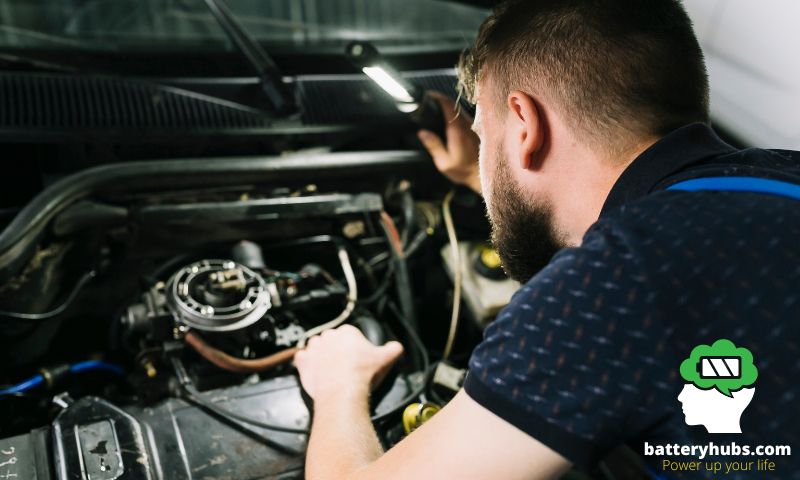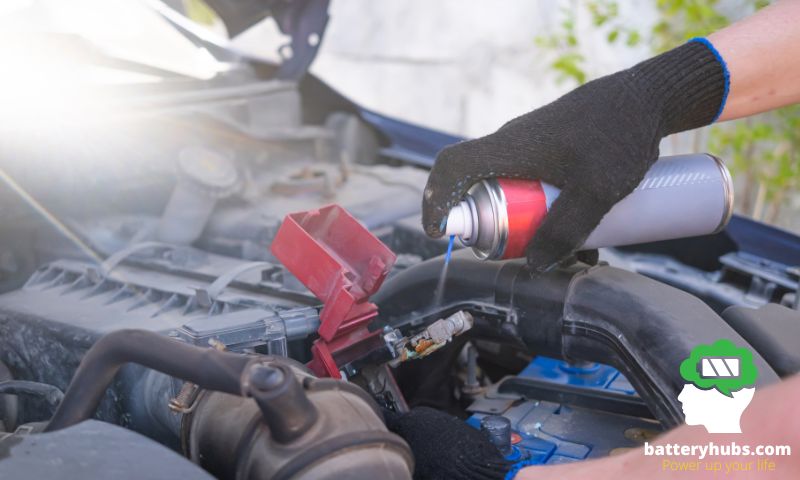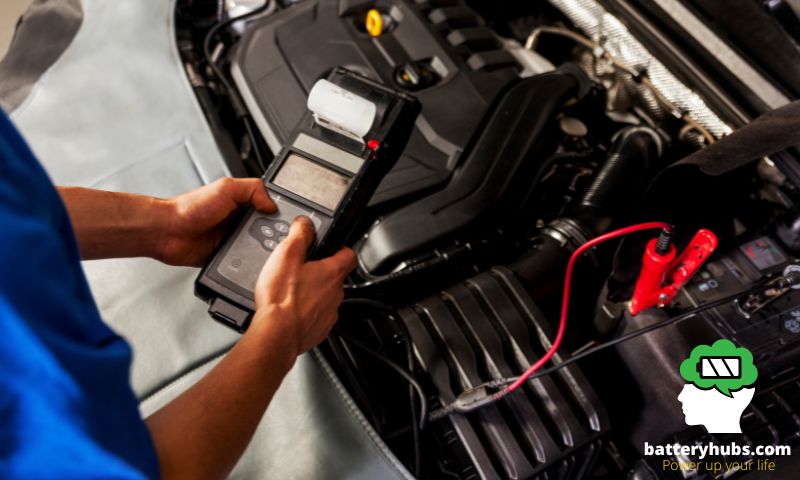I’m your friendly neighborhood battery expert, and I’ve been working with batteries for decades! Do you know what I’ve learned? Battery maintenance is absolutely crucial for maximizing performance and ensuring a longer lifespan. Did you know that a well-maintained battery can last up to twice as long as one that’s neglected? That’s right, I’ve seen it happen time and time again.
So, buckle up, because I’m going to share my wealth of experience and some super fun facts about battery maintenance with you. Together, we’ll keep your batteries running at their peak performance for years to come! Let’s dive in, shall we?
How do you properly maintain a battery?
As a seasoned battery guru, I can tell you that proper maintenance is the key to unlocking your battery’s full potential. So, let’s talk about some general tips, the importance of regular checkups, and the essential safety precautions you need to know.
General tips applicable to all types of batteries
No matter the battery type, these universal tips will keep your batteries in tip-top shape:
- Keep it clean: A dirty battery is an unhappy battery. Make sure to clean the terminals and case, removing any corrosion or dirt.
- Stay charged: Batteries love being charged. Don’t let them discharge completely, and top them off when needed.
- Store properly: Keep batteries in a cool, dry place, away from direct sunlight and extreme temperatures.
Now, let’s move on to the meat and potatoes of battery maintenance.
Importance of regular checkups and maintenance schedules
Just like you go to the doctor for regular checkups, your battery needs some TLC too. Here’s why:
- Regular maintenance helps extend your battery’s life.
- You can prevent common issues like corrosion, swelling, and leaks.
- It ensures your battery performs at its best.
“A stitch in time saves nine.” – Some wise person
Set up a maintenance schedule and stick to it. Trust me, your battery will thank you!
Safety precautions while handling batteries
We all want to keep our fingers intact, right? So, let’s talk about safety:
- Wear protective gear: Gloves and goggles are a must. Safety first, folks!
- Avoid sparks: Keep flames, sparks, and cigarettes far away from your battery. Kaboom is fun in movies, not in real life.
- Be mindful of polarity: Always disconnect the negative terminal first and reconnect it last.
Remember, safety is no joke when it comes to battery maintenance.
To sum it up, proper battery maintenance is all about staying on top of general tips, sticking to a regular checkup schedule, and observing safety precautions. Follow these guidelines, and you’ll be the proud owner of a happy, long-lasting battery!
What five steps are done during battery maintenance?
As someone who has spent countless hours tinkering with batteries, I’ve got the perfect 5-step routine for battery maintenance. So, let’s dive in and explore the process!
1. Visual inspection of the battery
The first step is to feast your eyes on the battery. You’ll want to:

- Check for any swelling, cracks, or leaks.
- Make sure the terminals are intact and tight.
- Look for corrosion or damage.
“The eyes are the window to the battery’s soul.” – A battery enthusiast (aka me)
2. Cleaning the battery terminals and connections
Once you’ve inspected the battery, it’s time to clean up the mess. You’ll need:

- A toothbrush or wire brush
- A mixture of baking soda and water
- Clean water for rinsing
Gently scrub the terminals and connections to remove any dirt, grease, or corrosion. Then rinse with clean water and let it dry.
3. Checking and adjusting electrolyte levels (for lead-acid batteries)
Now, if you’re dealing with a lead-acid battery, it’s time to get up close and personal with the electrolyte levels. Here’s what you need to do:

- Check the levels: Make sure the electrolyte covers the plates.
- Adjust if needed: Top off with distilled water if the levels are low. Never use tap water!
“Water, water, everywhere, but only distilled for batteries.” – A wise battery caretaker
4. Charging the battery
After your battery is clean and electrolyte levels are in check, it’s time for some juice. Connect your battery to a charger and:

- Charge at the recommended rate.
- Monitor the charging process to prevent overcharging.
Remember, a properly charged battery is a happy battery!
5. Testing the battery performance
The final step is to test your battery’s performance. You can use a multimeter or a battery tester to:

- Check the voltage.
- Measure the cold-cranking amps (CCA).
- Determine the state of charge.
With these five steps, your battery will be in tip-top shape and ready to power your adventures. Happy maintaining!
What maintenance does a car battery need?
As a seasoned battery expert, I can tell you that maintaining your car battery is a crucial part of vehicle ownership. So, let’s get started on the essential maintenance tasks to keep your car battery in peak condition.
One of the most important aspects of car battery maintenance is keeping it clean. This includes:
- Removing dirt, grease, and corrosion from the battery terminals and connections.
- Wiping down the battery casing to prevent the buildup of grime.
“A clean battery is a happy battery.” – Yours truly
Next up, let’s talk about charging your battery. You’ll want to:
- Drive your car regularly to keep the battery charged.
- Avoid using accessories or devices that drain the battery when the engine is off.
By following these tips, you’ll help prevent deep discharges that can shorten your battery’s lifespan.
To ensure your car battery is performing at its best, it’s essential to test it regularly. This includes:
- Checking the voltage with a multimeter or battery tester.
- Measuring the cold-cranking amps (CCA) to ensure it can start your engine even in cold weather.
These tests will give you a clear picture of your battery’s health and if it’s time for a replacement.
Tips for prolonging the life of your car battery
Lastly, here are some quick tips to help you get the most out of your car battery:
- Park in the shade or use a battery insulation blanket to protect it from extreme temperatures.
- Turn off accessories and devices when you’re not using your car to prevent unnecessary battery drain.
- Always disconnect the battery if you plan to store your vehicle for an extended period.
With these maintenance tips, your car battery will be raring to go, ensuring you’re always ready to hit the road.
What is the meaning of battery maintenance?
As an experienced battery enthusiast, I’m here to walk you through the ins and outs of battery maintenance. So, let’s dive in and explore the meaning of battery maintenance, its purpose, benefits, and how it can make a difference in your battery’s performance and lifespan.
Battery maintenance refers to the routine care and upkeep of a battery to ensure its optimal performance, safety, and longevity. This can include cleaning, inspecting, charging, and testing various aspects of the battery, depending on the type and usage.
The purpose and benefits of regular battery maintenance
Now that we know what battery maintenance means, let’s discuss its purpose and benefits. Regular battery maintenance can:
- Maximize performance: Proper maintenance ensures your battery delivers consistent power when you need it.
- Extend battery life: Taking care of your battery can help prolong its lifespan, saving you money in the long run.
- Enhance safety: Routine checks can help identify potential hazards and prevent accidents related to battery malfunction.
“Maintenance is the key to battery happiness.” – Battery Guru Me
How battery maintenance contributes to the overall performance and lifespan of a battery
Finally, let’s see how regular maintenance can boost your battery’s performance and lifespan. By staying on top of battery maintenance, you’re:
- Ensuring optimal charging and discharging cycles to prevent damage.
- Detecting and addressing any potential issues before they become bigger problems.
- Reducing the risk of unexpected battery failure, keeping you powered up and ready to go.
In short, battery maintenance is like giving your battery the TLC it deserves, ensuring it stays in tip-top shape for as long as possible. And as we all know, a well-maintained battery is a happy battery!
How often should you maintain your car battery?
As someone who’s spent years tinkering with batteries, I can tell you that timely maintenance is key to a healthy and happy car battery. So, how often should you maintain it? Let’s explore the recommended maintenance intervals, factors that may affect the frequency, and some signs that your battery needs immediate attention.
Recommended maintenance intervals for different types of batteries
Different types of batteries require different maintenance schedules. Here’s a quick breakdown:
| Battery Type | Recommended Maintenance Interval |
|---|---|
| Flooded Lead-Acid | Every 1-3 months |
| AGM | Every 3-6 months |
| Gel | Every 3-6 months |
| Lithium-ion | Minimal maintenance required |
“An ounce of prevention is worth a pound of cure, especially when it comes to batteries.” – Wise Battery Sage
Factors that may affect the frequency of battery maintenance
While the above recommendations are a good starting point, the frequency of battery maintenance may vary based on several factors:
- Usage: Heavy or frequent use can require more frequent checkups.
- Climate: Extreme temperatures can affect battery performance and maintenance needs.
- Vehicle age: Older vehicles may require more frequent battery maintenance.
- Driving habits: Short trips, frequent stops, and excessive idling can impact battery health.
Signs that your battery needs immediate attention
Now, let’s go over some telltale signs that your battery needs immediate care:
- Slow engine crank: If your engine takes longer than usual to start, your battery might need some love.
- Dimming headlights: Dim or flickering headlights could indicate a battery issue.
- Battery warning light: A lit battery warning light on your dashboard is a surefire sign that you need to check your battery.
- Swollen battery case: A swollen or bulging battery case could indicate overheating or overcharging.
By keeping an eye on these signs and staying proactive about your car battery maintenance, you’ll keep your battery running smoothly and efficiently for years to come. And remember, folks, a well-maintained battery is a happy battery!
How do you maintain different types of batteries?
As a seasoned battery guru, I’ve seen all kinds of batteries come and go. Trust me when I say, each type of battery has its own unique maintenance needs. So let’s dive into the exciting world of battery maintenance for lead-acid, lithium-ion, and nickel-based batteries.
Lead-acid batteries
Lead-acid batteries are the most common type of batteries out there. Here’s how to care for them, based on their subtype:
| Battery Subtype | Maintenance Tips |
|---|---|
| Flooded | Regularly check and adjust electrolyte levels, clean terminals, and perform equalization charges |
| AGM | Keep terminals clean, avoid overcharging, and store in a cool, dry place |
| Gel | Be cautious with charging (use a gel-specific charger), clean terminals, and avoid overcharging |
Keep in mind that for all lead-acid batteries, it’s important to perform regular load tests and visual inspections.
Lithium-ion batteries
Lithium-ion batteries are the cool kids on the block, and they require less maintenance than their lead-acid counterparts. Here are some tips to keep them in tip-top shape:
- Use a charger specifically designed for lithium-ion batteries
- Store at a partial charge (around 50%) in a cool, dry place when not in use
- Avoid overcharging and over-discharging
- Monitor the battery temperature during charging and discharging
Nickel-based batteries (NiMH and NiCd)
Nickel-based batteries may not be as popular as they once were, but they still have their fans. Here’s how to maintain them:
- Use a charger designed for nickel-based batteries
- Periodically perform a full discharge and charge cycle to prevent the “memory effect”
- Store in a cool, dry place
- Avoid overcharging and over-discharging
Maintenance tips specific to each battery type
Each battery type has its own quirks and maintenance needs, so it’s essential to know how to keep them running smoothly. Here’s a handy table summarizing the key maintenance tips for each battery type:
| Battery Type | Key Maintenance Tips |
|---|---|
| Lead-acid | Check electrolyte levels, clean terminals, perform load tests, and use proper chargers |
| Lithium-ion | Use nickel-based chargers, perform full discharge cycles, store in a cool, dry place, and avoid overcharging |
| Nickel-based | Use nickel-based chargers, perform full discharge cycles, store in a cool, dry place, avoid overcharging |
By giving your batteries the care and attention they deserve, you’ll keep them running efficiently and extend their lifespan. And remember, my fellow battery enthusiasts, a little TLC goes a long way in the world of batteries!
How do you maintain battery accessories and charging equipment?
Hey, fellow battery aficionados! So, you’ve got your batteries all sorted out, but what about those essential accessories? You know, the chargers, cables, and other gadgets that keep our batteries juiced up and ready to go? Fear not, because I’m here to share some electrifying tips on maintaining battery accessories and charging equipment.
Proper care and storage of battery chargers and cables
Taking care of your chargers and cables is just as important as maintaining your batteries. Follow these sizzling tips to keep your charging equipment in pristine condition:
- Unplug chargers when not in use to prevent potential damage and save energy
- Gently roll up cables and use a cable tie or Velcro strap to prevent tangling
- Store chargers and cables in a cool, dry place away from direct sunlight
- Keep them away from liquids and corrosive materials
- Inspect cables regularly for any signs of wear, damage, or fraying
Tips for maintaining a healthy charging environment
A healthy charging environment is essential for your batteries and charging equipment. Here are some electrifying tips to ensure a safe and efficient charging process:
- Keep the charging area clean and free of debris
- Ensure proper ventilation to prevent overheating
- Position charging equipment on a stable, non-conductive surface
- Avoid overloading electrical outlets and use surge protectors
- Regularly check chargers for any signs of wear or damage
Signs that your charging equipment may need maintenance or replacement
As much as we’d like them to last forever, charging equipment will eventually need maintenance or replacement. Here’s a handy table to help you spot the warning signs:
| Signs of Trouble | Possible Causes | Solutions |
|---|---|---|
| Charger not turning on or functioning | Damaged charger, blown fuse, faulty power supply | Check and replace components, if needed |
| Swollen or damaged cables | The charger not turning on or functioning | Replace cables |
| Inconsistent or slow charging | Faulty charger, damaged cables, poor connections | Inspect and replace equipment, if needed |
| Overheating chargers or charging equipment | Overloading, poor ventilation, malfunctioning parts | Check ventilation, replace components |
By properly maintaining your battery accessories and charging equipment, you’ll ensure a safe and efficient charging process for your batteries. So go forth and conquer the world of battery maintenance, my friends, and remember to always stay charged!
Conclusion
And there you have it, my fellow battery enthusiasts! We’ve explored the fascinating world of battery maintenance, covered essential tips for different battery types, and even dived into the care of those crucial accessories and charging equipment. As someone who’s been around the battery block a few times, I can’t stress enough the importance of regular battery maintenance. It not only keeps your batteries performing at their best but also helps extend their lifespan, saving you both time and money.
Remember to always stay safe when working with batteries and charging equipment, and don’t be afraid to seek professional help if you’re unsure about anything. Keep your batteries healthy, and your charging equipment in tip-top shape, and you’ll be a certified battery maintenance guru in no time. Happy charging, my friends!
Now that you’ve become well-versed in the art of battery maintenance, it’s time to delve deeper into the fascinating world of batteries. At Battery Hubs, we’re dedicated to empowering you with a wealth of knowledge on everything related to batteries. Explore the science behind how batteries work, learn about the journey of electricity from a battery, and even unravel the mystery behind rechargeable batteries.
As you expand your knowledge, don’t forget to stay updated on the environmental impact of batteries and compare different battery chemistries to make informed decisions when choosing the right battery for your needs. With our comprehensive guides and expert advice, you’ll soon become a true battery aficionado!
So go ahead and dive into our treasure trove of battery-related knowledge. Remember, a well-informed battery enthusiast is an empowered one. Happy learning!
